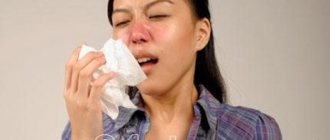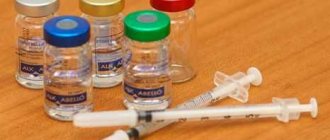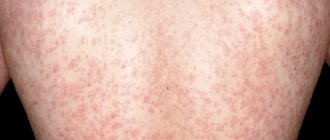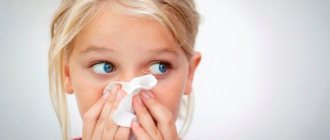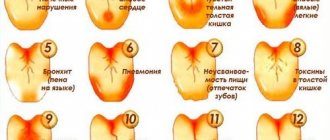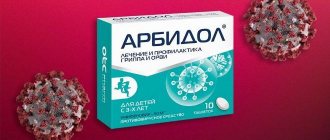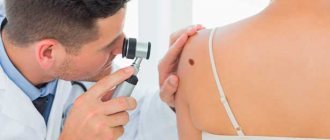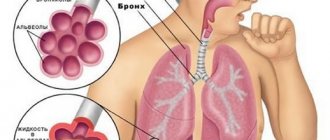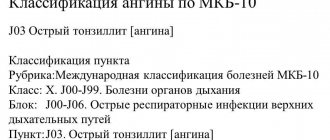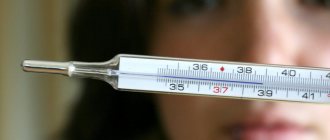Sinusitis is an inflammation of the maxillary sinus, which, after the name of the English ENT doctor who first described it, is called the maxillary sinus. It is connected to the nasal cavity by narrow outlet openings (orifices) only 1–3 mm in diameter (slightly larger than the diameter of a fountain pen). Inflammation of the nasal cavity causes swelling, and the swelling quickly covers these same anastomoses. As a result, the maxillary sinus initially closes partially, and if treatment is not started in time, it becomes completely blocked. White blood cells rush into the blocked sinus to fight inflammation. Everyone probably remembers from their school biology course that their task is to destroy the infection. This is how acute catarrhal sinusitis begins. If proper treatment is started at this time, the chance that sinusitis will not become purulent or become chronic is very high.
Purulent sinusitis: treatment and correct diagnosis
The number of foreign bacteria can be huge, then in response the body produces the same huge number of leukocytes (diagnosed by a symptom such as leukocytosis). An increased ESR (erythrocyte sedimentation rate) and a significantly higher than usual level of leukocytes in a general blood test will show the doctor the condition of the so-called inflamed blood.
But it also happens that leukocytes are unable to overcome the infection and die. Pus is formed - an accumulation of dead leukocytes. Then this is already purulent sinusitis - treatment should be immediate and correct.
When mucopurulent masses cannot leave the maxillary sinuses, they begin to “ferment.” Any sane person will understand that it’s time to go to the ENT clinic. It’s better not to joke with purulent inflammation flaring up near the brain! You need to see a doctor without waiting for sinusitis to become chronic and other dangerous complications.
So much for your runny nose!
There are many things in the world that can ruin our lives. But, in addition to objective reasons - politics, bosses, weather, there are also subjective ones - our health, for example. Some innocent runny nose or an unhealed upper tooth - what could be simpler! - can easily turn into sinusitis. And the thing is done - your head hurts, your voice is nasal, it’s hard to breathe, you can’t feel any smells... You shouldn’t be happy about the fresh borscht, nor should you choose cologne for your boyfriend or flower perfume for your girlfriend. In a word, life is not a joy. What can we say about meningitis or brain abscess, which can occur if sinusitis is not treated!
How to recognize sinusitis: symptoms
The first sign of sinusitis is a constantly stuffy nose. Usually, congestion is felt more strongly on the side of inflammation. In case of bilateral - on both sides. Nasality may appear.
Another symptom is pressure in the nose. Often there is pain in the cheek area, as well as at the bottom of the eye socket. The patient may feel pressure in the eyeballs and lower eyelids. In the morning the pain is usually unnoticeable, but becomes very noticeable in the evening. Due to the unclear localization, the patient sometimes thinks that the cause is simply a headache. Pain in the maxillary sinus, in the perception of a person, can be transferred to the teeth of the upper jaw.
A common sign of sinusitis is swelling of the cheeks and lower eyelids. And sometimes on the inflammation side there are the upper ones.
Yellow and green nasal discharge with an unpleasant odor is another sign of inflammation.
The thermometer usually shows up to 38°C and above. But subfebrile (37.1–37.5°C) temperature with sinusitis is not a rare sign. This occurs more often in chronic forms of inflammation.
The chronic form of sinusitis is characterized by a long, sluggish course and is accompanied by symptoms that worsen the patient’s quality of life
Fatigue and loss of appetite are signs of both acute and chronic sinusitis. Patients, due to general weakness, usually have reduced performance and troubled sleep
Physiotherapy and laser therapy
Many people are interested in how to permanently get rid of the manifestations of sinusitis as easily and effectively as possible. Physiotherapy has a good effect. The doctor, along with medications, prescribes a course of physiotherapeutic procedures to the patient; the active substance penetrates directly to the damaged sinus. In addition, such procedures are considered completely safe and do not cause any harm at all. For sinusitis, the following physiotherapy procedures are performed:
- impulse currents;
- electromagnetic waves;
- ultrasound therapy;
- electrophoresis;
- mud therapy;
- carrying out inhalations.
All physiotherapeutic procedures are aimed at quickly eliminating inflammation, improving the outflow of nasal sinus contents, and eliminating pain. In the chronic stage of sinusitis, laser therapy is often used. This is a fairly good and effective procedure, during which a laser beam is directed to the damaged area through the nasal passage, which helps eliminate swelling, inflammation, and also helps get rid of pathogens.
Laser therapy is characterized by the fact that it is a completely painless procedure, and it is also non-traumatic, despite the fact that it has a significant duration. The course of therapy is 7-10 procedures.
Factors provoking sinusitis
People with a deformed nasal septum are at risk of developing sinusitis. Hypertrophied (enlarged) inferior turbinates also contribute to the development of the disease, since they close the exit to the anastomosis. Other anatomical changes in the nasal cavity can also provoke sinusitis.
Various formations, what ENT doctors themselves usually call “plus tissue”: polyps in the nasal cavity and paranasal sinuses, cystic formations and other growths also increase the risk of sinusitis.
Weakened local immune defense due to previous illness, allergies and autoimmune diseases can also contribute to the development of inflammation.
Environmental factors can also provoke the development of sinusitis: gas pollution, harmful working conditions, dust, etc.
How long does it take to treat sinusitis?
The duration of treatment for sinusitis depends on the cause of the development of sinusitis, how it progresses and whether its treatment is started in a timely manner. If the disease is caused by a bacteria, treatment can last about 2-3 weeks. When the cause of nasal congestion is an allergy, treatment can even last for months. For example, if it is impossible to eliminate the allergen (in particular, during the flowering period of trees).
Many people do not treat an incipient runny nose, which provokes the development of complications. As a result, prolonged nasal congestion leads to the development of acute or purulent sinusitis. When a runny nose appears, it is better to always seek help from an otolaryngologist and not wait for rhinitis to become complicated by sinusitis.
Modern treatment of sinusitis without puncture
To treat sinusitis without a puncture, they carry out “mild” antibacterial and probiotic therapy, that is, they use antibiotics, so to speak, of medium strength. The most commonly used probiotics are Normoflorin, Linex, Bion-3 and others. Drugs are prescribed to relieve edema, as well as have a vasoconstrictor effect. Emollients are used to restore the nasal mucosa. This could be Pinosol, Euphorbium compositum, etc. To restore the mucous membrane, Sinupret is most often used. To rid the body of germs and inflamed masses, the paranasal sinuses are washed with Aqualor, Dolphin, Aquamaris (at the doctor’s choice and, of course, depending on the patient’s tolerance); Octenisept, Dioxidin, Miramistin and other antiseptics are used.
“Cuckoo” (rinsing all paranasal sinuses) is prescribed as a procedure for removing mucopurulent masses, as well as for antiseptic and antibacterial treatment of the nasal cavity and nasopharynx.
Is sinusitis treated in hospital or at home?
Sinusitis does not require hospitalization if treated in a timely manner. First of all, in case of acute sinusitis, the doctor’s attention is directed to relieving swelling of the nasal sinuses. The patient must remain in bed and follow the list of medical recommendations.
Those diagnosed with sinusitis are prescribed antibiotics, anti-inflammatory, antibacterial, vasoconstrictor and decongestant drugs. Physiotherapy procedures are selected individually. If pus has collected in the nasal sinuses, the patient is indicated for a puncture (puncture) on an outpatient basis. After the puncture, the maxillary sinuses are washed with an antiseptic solution. You cannot treat sinusitis on your own. This may lead to complications. For example, with sinusitis, any warming procedures are prohibited. Heat provokes the appearance of pus in the sinuses and can lead to the development of meningitis.
Surgical route
When sinusitis is advanced, you can no longer manage with medications alone. Then they make a puncture. Or, in medical terms, a puncture of the maxillary sinus. The goal is still the same - to extract mucopurulent discharge and deliver medicine to the inflamed area.
Puncture of the maxillary sinus is a therapeutic and diagnostic procedure. It is also carried out in cases where it is difficult to determine the type of sinusitis, or there are doubts about the cause of the patient’s illness.
With all the advanced modern equipment, there are situations when research results, patient complaints and disease history data contradict each other. Only a puncture will help the doctor understand what’s wrong and will dot all the i’s.
Friends! Timely and correct treatment will ensure you a speedy recovery!
Despite the fears of patients, puncturing the sinuses with a Kulikovsky needle is the most effective technique, and that is why it is used more often than non-surgical methods of treating sinusitis.
Having made a diagnosis, the ENT doctor informs the patient in detail about the disease and treatment options, but the patient will have to decide whether to make a puncture or not.
YAMIK sinus catheter: is it a panacea?
Let me say right away that it is not a panacea. But this method of treating sinusitis also has disadvantages. And, alas, quite significant.
- The YAMIK catheter cannot be sterilized in a dry-heat oven - it will simply melt. In an autoclave it’s difficult, but possible. After autoclaving, the properties of the rubber change, it becomes less elastic, the balloon itself often sticks together, and this makes subsequent rinsing difficult. Another method of sterilization is a strong antiseptic solution. But if you overdo it with its concentration, the shell of the balloon may become thinner, and the balloon may break during the procedure. An explosion of a ball in the nasopharynx is painful and unexpected, and it is impossible to file a claim with the doctor: the office or dressing nurse sterilizes the instruments.
- One YAMIK procedure is performed on one inflamed side. In case of bilateral inflammation, you will have to do a full second manipulation.
- YAMIK catheterization is ineffective or, more correctly, difficult to perform for patients with a deviated nasal septum.
- Sometimes the YAMIK catheter, due to strong contact with the mucous membrane of the nasal cavity, tears it and provokes severe and difficult to stop bleeding. The problem in the vestibule of the nose is solved quite quickly, but if the posterior sections of the nasal cavity are “opened up,” everything is much more complicated.
- YAMIK sinus rinsing occurs due to the jerky movement of the liquid, which is created by the piston of a plastic syringe (in a propulsive manner). Accordingly, there is no need to talk about the exact penetration of the medicine into the inflamed maxillary sinuses.
- There is a possibility of contamination of healthy neighboring sinuses on the side of the lavage with purulent masses, since pus under pressure can get there too. But the method, alas, does not allow you to rinse only the inflamed sinus.
- Yes, there will be no puncture. But the increase in the volume of the balloon in the nasopharynx is painful enough that patients regret that they did not agree to the puncture. Otherwise it is impossible - you need to create a certain level of pressure for flushing.
- It is impossible to rinse your sinuses in one minute (or rather, it is possible, of course, but poorly). A high-quality procedure takes 10–15 minutes. It is impossible otherwise, it is ineffective. And all this time the patient groans in pain. Despite the anesthesia. Unfortunately, the method of complete anesthesia does not provide.
- With a deviated nasal septum, the YAMIK catheter sometimes has to be inserted with tweezers and with force. It hurts too. And the catheter can be torn.
- And one more important detail: the cost of medications and medical instruments. With this procedure, the patient will have to pay for the YAMIK catheter itself, and for anesthesia, and for lavage. If the inflammation is bilateral, then there will be two manipulations: two sets of medications, two anesthesia, bilateral contraction of the mucous membrane and bilateral lavage. Expensive. Twice as long. And it will hurt twice too.
YAMIK, of course, is not a puncture, but it is not a panacea for sinusitis. But a patient who has read a lot of medical advertising begins to understand this only during the procedure itself, when he already has to endure for the doctor to complete the job. And then he regrets that he did not listen to the doctor.
And now, attention - easy breathing!
If you are already so intimidated that you are afraid to even think about visiting a doctor, the most direct route to us. This is perhaps the main problem - “medical phobia”, distrust of a man in a white coat. But this can be dealt with - every person has the right to care and attention, to an individual approach. If the psychological stress for some personal reasons is too great, a professional psychologist will help you relieve it. When you, like a bad dream, forget that it was difficult for you to breathe, then we will consider your treatment complete. Do you know what is most important? — our patients leave smiling, because they breathe freely again, just breathe, without thinking, enjoying life!
Antibiotics for sinusitis
The following popular antibacterial drugs in the form of sprays are considered the main means of combating sinusitis, such as:
- polydex with phenylephrine – 430 rubles;
- isofra – 170 rubles;
- bioparox – 390 rubles;
- phenylephrine – 430 rubles.
These drugs destroy bacteria, relieve inflammation and swelling, and help thin thick mucus.
Bioparox is considered a less aggressive antibiotic, so it is most widely used in pediatrics. Fusafungin (the main active ingredient of bioparox) affects fungal and bacterial flora. The anti-inflammatory effect of the drug is quite high.
An article on the topic - instructions for using bioparox for a runny nose.
Isofra also actively destroys both bacteria and fungi. The active ingredient of the spray is framycetin.
Polydex spray with phenylephrine is a complex medicine and contains two antibiotics - neomycin and polymyxin, so the medicine covers a wide range of pathogenic microflora. Phenylephrine complements the drug with a vasoconstrictor property, which relieves swelling, and dexamethasone sodium metasulfobenzoate, which is also included in the product, has a pronounced anti-inflammatory effect.
If necessary, the doctor prescribes a systemic antibiotic (tablets, capsules, suspension, syrup). The most commonly used drugs are: flemoxin salutab, amoxiclav, augmentin, sumamed, macropen, cefuroxime, ofloxacin, ciprofloxacin, levofloxacin and others.
We described most of these medications in the section on drugs for the common cold.
Is it possible to take antibiotics and antivirals together?
Do no harm!
Some remedies that are used for sinusitis can do more harm than good, especially if used without a doctor’s recommendation. Let's talk about some of them.
Physiotherapy . Physiotherapy for sinusitis is not the main one; it is prescribed according to indications as an additional method. Laser therapy, magnetic therapy, inhalations, high-frequency currents, and ultraviolet radiation are often used. But if you have any physiotherapy device at home, you should consult your doctor before using it. The fact is that in some cases, especially if pus accumulates in the sinuses and does not come out, heating and other physical procedures can increase inflammation and cause complications. For the same reason, you should not warm up your sinuses with hot eggs or resort to steam inhalations.
Vasoconstrictor drops . They are almost always used for sinusitis, but only in short courses - no longer than 5 days. Long-term use of vasoconstrictor drops harms the nasal mucosa and can lead to addiction, when the drops provide relief only for a few minutes, after which the nose becomes stuffy again. As a result, a person ends up in a vicious circle - the more often he uses the drops, the worse his nose can breathe, which means that an increasingly larger dose of medication is required.
How can birch buds help with sinusitis? More details
Rinse the nose with a solution of sea salt . This procedure improves the flow of mucus from the sinuses, so it is often prescribed for sinusitis. You can make your own saline solution from components purchased at the pharmacy (sea salt and drops of iodine), or purchase ready-made forms. To irrigate the nasal cavity, it is better to use special spray bottles with a fine spray or a more powerful jet, which is directed into each half of the nose for 10 seconds. But keep in mind that nasal rinsing should not be done under pressure, using an enema or syringe. And most importantly, rinsing, like other treatments, should be prescribed by a doctor. He will also determine the duration of the procedure. After all, if you use a saline solution for too long, it will lead to the opposite effect - irritation of the mucous membrane, increased swelling and nasal congestion.
Tips for treating sinusitis
Do not forget that sinusitis is an infectious pathology, so experts recommend using disposable tissues or regularly changing tissues to clean ones so that the infection does not spread.
In addition, the mucous membrane needs constant hydration. To do this, it is necessary not only to increase the amount of fluid you drink, but also to use special saline solutions for the nose and humidify the air so that the mucous membrane does not dry out. Add spicy foods to your menu - mustard, pepper, and so on. Such products have a mucolytic effect, as they irritate the mucous membrane. But the amount of dairy products should be reduced.
But what to do if a person has lost his sense of smell? To do this you need to follow several steps:
- Pour a little 9% vinegar into a hot frying pan and then inhale its vapors.
- Crush the root of the leaf and bergenia, then take this powder one tablespoon at a time, wash it down with warm jelly or other liquid.
- When going outside, massage your neck.
Questions and answers from ENT specialists
Question 1. How to alleviate the condition of a patient with acute sinusitis at home
Answer. Frequent companions of acute sinusitis are high body temperature and headache. Therefore, first aid for sinusitis at home should be aimed at eliminating these symptoms. To do this, you can take an antipyretic tablet and, if necessary, an analgesic. This is an ambulance. You need to see a doctor as soon as possible to prescribe adequate therapy.
Question 2. How to relieve swelling from sinusitis. Are there ways to do this quickly?
Answer. Inflammation of the maxillary sinuses is accompanied by tissue swelling. This condition aggravates the disease, interferes with the outflow of mucus, and disrupts nasal breathing. To relieve swelling, use vasoconstrictor drops and sprays (Naphthyzin, Sanorin, Nazivin or similar). If the swelling is severe, in addition to the drops you can take an antihistamine (Claritin, Erespal, etc.). Short-term relief will come from sucking on mint candies as a local irritant. These funds should not be abused. If you have the first suspicion of sinusitis, including swelling, consult a doctor as soon as possible. He will prescribe comprehensive treatment. Timely prescribed therapy allows you to avoid complications and surgical interventions.
Question 3. What products are suitable for rinsing the nose with inflammation of the maxillary sinuses at home?
Answer. The purpose of rinsing is to remove pus, mucus, and pathogens from the nose and maxillary sinuses. For the procedure, ready-made pharmaceutical solutions for washing the upper respiratory tract based on sea water or saline are used. In the absence of such means, you can prepare the solution yourself at the rate of a teaspoon of salt per 0.5 liter of warm water. But here you need to understand that everyone has their own sensitivity. If the resulting remedy causes noticeable discomfort and stings the mucous membrane, there is no need to endure it. The solution must be diluted more strongly. The main condition for washing is the temperature of the liquid. It should be pleasantly warm (36-37 degrees).
Inhalations
A qualified doctor of a narrow specialty will tell you how to cure sinusitis with folk remedies using inhalations. It is recommended to carry out procedures at the first manifestations of sinus congestion and impaired functioning of the respiratory tract. For sinusitis, sessions are carried out using medications and traditional medicine.
A convenient method of therapy will quickly relieve the source of inflammation and prevent complications. The procedures promote the healing of damaged mucous membranes and maxillary sinuses. With their help, purulent accumulations are liquefied and removed from the nasal passages without difficulty.
Inhalations are an assistant for sinusitis for adults and young patients without leaving home. Modern medicine recommends conducting sessions using a special nebulizer apparatus. By following recommendations that have been proven over the years, the disease can be effectively eliminated in a short period of time:
therapy should be carried out at the first symptoms of a cold; medications need to be changed depending on the form of the disease; the procedure is permitted at a temperature not exceeding 38 degrees; the nasal passages must be moistened with saline solutions before the session; before and after inhalation, it is important to refrain from eating for 30 minutes; solutions should be at room temperature; The duration of the session for adults should not exceed 10 minutes, for children 5 minutes.
Medicines are selected individually, taking into account the patient’s age, the form of the disease, individual tolerance of the ingredients, and the severity of the pathology. The therapy is not recommended for patients with cardiac or cardiovascular pathologies. Inhalation is prohibited when diagnosing bullous emphysema and pneumothorax. If the nasal sinuses are swollen, the mucous formations should first be removed so that the drug particles penetrate into the infected areas.
For thermal inhalations, folk remedies for sinusitis and sinusitis are used, prepared on the basis of herbal plants and essential oils. Classic recipes eliminate acute inflammation, increase immunity, and expel pathogenic bacteria, viruses, and microorganisms from the body. To prepare decoctions, it is recommended to use:
- Raw materials of chamomile, thyme and sage. Add 500 ml to the herbal collection. water. Bring the product to a boil in a steam bath, then cook over low heat for 3-5 minutes.
- 30 ml. Propolis tinctures are mixed with a glass of water.
- Chopped horseradish and garlic roots diluted in 0.5 liters of boiled water will help clear the nasal passages of pus and mucus.
- A collection of calendula, eucalyptus, and raspberry leaves can stop the inflammatory process.
- A decoction of bay leaves is highly effective for sinusitis.
It is important to carry out thermal inhalations at normal body temperature. You need to inhale the vapors through your nose
After the session, it is advised to wrap yourself warmly and relax. You cannot immediately go out into the fresh air, so as not to provoke complications.
Thermal procedures are contraindicated in case of accumulation of purulent masses in the maxillary sinuses. If the patient experiences nosebleeds, the therapy should be discontinued.
How to deal with the disease - drug treatment
Pharmaceutical drugs are prescribed for the treatment of sinusitis of any form, stage and severity. The choice of a specific remedy is determined by the doctor, taking into account age and characteristics of the disease. They can be in the form for internal use, but topical medications are most effective. Their effectiveness is achieved through direct contact with the inflamed area.
Antibiotics
Prescribed only for sinusitis of a bacterial nature, before preparing for surgery and after surgery. May cause adverse reactions, the course of treatment is limited to 5-7 days. Antibiotics for sinusitis:
- Isofra . Antimicrobial nasal spray based on framycetin. Suitable for adults and children. Cost from 340 rub.
- Amoxicillin . Available in the form of powder for suspensions, tablets and capsules. Contains a broad-spectrum antibiotic. Contraindicated in case of sensitivity to penicillin. Price – from 65 rub.
- Suprax . The active substance is cefixime. Semisynthetic antibiotic 3rd generation. Has a powerful effect, suitable for children over 5 years old. Cost from 600 rub.
When a dry crust forms on the surface of the nostrils, antimicrobial ointments (Vishnevsky, ichthyol, Levosin) are prescribed. Recommended for routine treatment of nostrils and turundas.
With long-term use, antibiotics lose effectiveness - bacteria develop resistance to the active component.
Antiseptics
Prescribed for rinsing the nose with complicated sinusitis. Prescribed to prevent bacterial infection. Effective antiseptics:
- Miramistin. Antiseptic drug in the form of a solution. Capable of destroying the cellular structure of pathogenic microorganisms. Safe for health. Cost from 200 rub.
- Chlorhexidine. A cheap antiseptic, active against most bacteria and some viruses. Contraindicated in children and during pregnancy. Price – from 15 rub.
- Lugol's solution. The active substance of the composition is iodine. The auxiliary components are glycerin and plain water. The dosage must be observed; there is a risk of adverse reactions. Do not take during breastfeeding or pregnancy. Cost from 72 rub.
Some drops and nasal sprays have an antiseptic effect. Combined drugs are convenient because they reduce the pharmacological load on the body and allow you to save money.
Vasoconstrictors
Available in the form of drops or spray. Allows you to relieve swelling and congestion for a limited period. Vasoconstrictor drops are addictive and cause medicinal rhinitis, so it is important to observe the duration of treatment. Preparations:
- Naphthyzin. Drops based on naphazoline, excipients - boric acid, purified water. The course of treatment is limited to 5 days. Cost from 15 rub.
- Nazol. Available in forms for children and adults. The active ingredient is oxymetazoline. Useful for sinusitis complicated by allergies. Price – from 160 rub.
- Galazolin. Polish drops with xylometazoline. It has contraindications; it is important to read the instructions before use. Price – from 45 rub.
It is not recommended to abuse vasoconstrictor drugs. They dry out the nasal mucosa, which leads to complications of the disease. The maximum duration of treatment is 7 days.
Antihistamines
They are prescribed for the treatment and prevention of sinusitis of an allergic nature. They act on receptors, reducing the severity of symptoms - eliminating itching, lacrimation and congestion. Popular drugs:
- Allergodil. Azelastine based spray. It has high bioavailability and rarely causes side effects. Suitable for the treatment of acute sinusitis. Cost from 450 rub.
- Cromohexal. Antiallergic spray, the active substance is a salt of cromoglycic acid. When taken, temporary irritation of the mucous membrane is possible. Price – from 170 rub.
- Nasonex. Nasal spray from GCS groups. Contains mometasone, which has powerful anti-inflammatory and antiallergic effects. Recommended for a short course. Price – from 820 rub.
Causes of allergic sinusitis and typical body reactions
Allergy medications are also used to prevent exacerbation of chronic sinusitis in the spring and autumn. Help prevent relapse of the disease by reducing sensitivity to external factors.
If you have allergies, antihistamines should always be in your home medicine cabinet. They are recommended to be taken before possible contact with an irritant that triggers a pathological reaction.
Mucolytics
These are means for thinning and removing mucus from the sinuses. Helps relieve swelling, congestion and restore breathing. The best mucolytics:
- Sinuforte. Herbal product. Normalizes the viscosity of nasal mucus and enhances its removal. Price – from 2 thousand rubles.
- Ambrohexal. Available in the form of syrup and tablets. The active ingredient is ambroxol. Effective for sinusitis complicated by cough. Price – from 100 rub.
- Libexin. A drug based on carbocisteine. Has a powerful mucolytic effect. Contraindicated under the age of 15 years. Price from 500 rub.
Drugs in this group are usually used for bacterial sinusitis. They have little effectiveness during the recovery period, for the treatment of mild sinusitis.
Herbal remedies
As part of drug therapy, drugs based on medicinal plants are prescribed. They have a powerful effect, but are less likely than classical medications to cause adverse reactions. Popular drugs in this group:
- Pinosol. Nasal drops based on pine, eucalyptus and peppermint oils. It has an anti-inflammatory and antiseptic effect, normalizes breathing. Price from 150 rub.
- Eucasept. Herbal drops containing vitamin E, peppermint ester and fir oil. Helps relieve congestion and eliminate signs of sinusitis. Cost from 140 rub.
Homeopathic remedies are of plant origin. They contain a substance in low concentration, which normally causes an increase in symptoms. Their effectiveness has not been proven by research and is often used as a placebo.
Herbal preparations can be used as prophylaxis. They have a gentle effect on the body.
